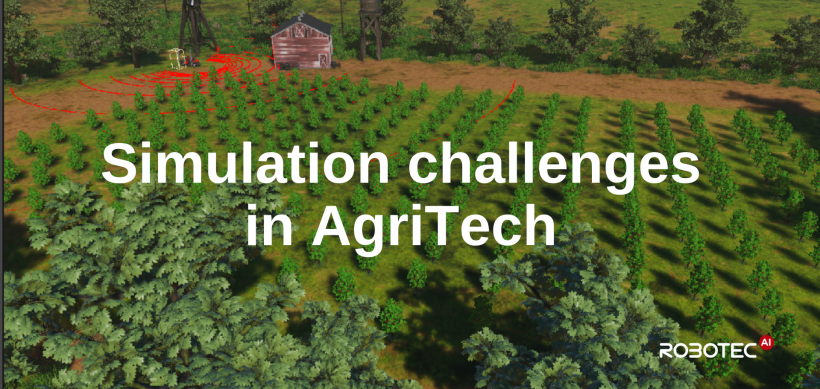Enter the search phrase

In the 21st century, global agriculture faces many challenges, from growing food demand and sustainability concerns to labor shortages that threaten the continuity of food supply chains. How can an understaffed industry begin to produce more food within decades if the situation is only predicted to deteriorate? The answer may lie in agricultural robots. Robot-assisted agriculture is no longer a vision for the future, but a reality for many agricultural companies. To work alongside humans, agribots must be carefully tested for safety. Here is where robotic simulations prove useful. Ultimately, they help eliminate errors before they can occur in real life. Bringing agricultural scenes to life has its own set of challenges to consider for every project. How do our simulation teams clear a path for successful agricultural simulations?
Agricultural fields are typically vast, just like orchards and vineyards, and they must be carefully reconstructed in the digital environment for safe and efficient robot navigation. The numbers of plants on farms are endless and most of them must be simulated. Imagine an orchard simulated for apple picking: every apple is a separate object that we must create. The devil lies in details, as they say, and in this case, the sheer number of necessary objects is the root of the simulation problems. Creating multiple highly accurate objects that closely resemble real life is time-consuming. Plants tend to have many branches and leaves, but are they all necessary? Simulation teams have to decide on the level of detail required for lidars. The rule is simple: accuracy cannot compromise performance.

Think about the fields and their uneven surface: what physical factors would be necessary for agribots that naturally navigate such terrain? Terrain resolution is crucial, especially concerning robot size and wheel dimensions. Larger robots handle tiny bumps easily, but for smaller robots, every uneven surface poses a notable challenge. Tailoring resolution to robot specifications is essential for simulation success.
You cannot escape physics, so everything has to be properly mapped, for example with location mapping algorithms. Materials are assigned to an object based on friction factors. Is it concrete? Is it grass? It all matters as the material is assigned both to the terrain and the wheel. Determining the right physical factors to consider and contact models to adapt is crucial for effective simulations.
Many robots have suspension systems in place to stabilize them. You must always make sure that they are properly coordinated. Robots have to behave naturally – neither move too much nor be too stiff. Balance is the key.
A detailed environment with multiple objects makes for a great appearance but can hinder great performance. The key is to strike a balance between them to create effective, yet detailed robotic simulations. How to do it? Determine the focus of each autonomous task. For example, vision-focused tasks must have good light. If it is not photorealistic, then vision cameras will not work properly. In fact, the grip topology is of little importance without the right lightning.
With lidars, the main focus is the accurate representation of models. To prioritize performance, we simplify models as much as necessary, especially in complex agricultural simulations. Sometimes certain things are painted and flat rather than modeled and multidimensional. Every process has to be adjusted to the purposes of the simulation. In large-scale simulations, it is important to minimize the level of necessary details, because they dramatically lower the performance.

What is important to note is that many agricultural simulation challenges are typical simulation challenges but on a much larger scale. Agribots must navigate the terrain safely, and thus have their entire environment mapped out in great detail. Still, accuracy should never come at the cost of performance. Consequently, one of the greatest AgriTech challenges is striking a balance between efficiency and appearance. If you want to see our agricultural simulations in action, head to our GitHub page to see our ROSCon 2022 demo.
Interested in our latest projects? Follow us on LinkedIn to always stay updated!
Authors: Piotr Jaroszek, Team Lead (the Simulation Engines department) at Robotec.ai
Justyna Toton, Copywriter at Robotec.ai